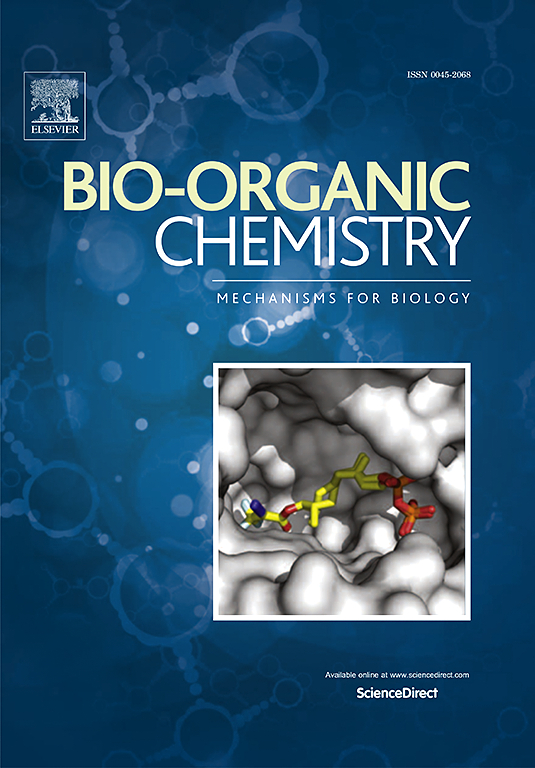Structure-activity relationship explorations of 2-(isoxazol-5-yl)phenyl-3,4-dihydroxybenzoate derivatives to develop potent Wnt/β-catenin pathway inhibitors for colorectal cancer treatment
IF 4.5
2区 医学
Q1 BIOCHEMISTRY & MOLECULAR BIOLOGY
引用次数: 0
Abstract
In the canonical Wnt/β-catenin pathway, the nucleus translocation of β-catenin and β-catenin/ B-cell lymphoma 9 (BCL9) protein-protein interactions (PPI) promote the expressions of oncoproteins (Cyclin D1 and C-myc), thereby inducing the colorectal cancer. Herein, we report the identification of the highly potent Wnt/β-catenin pathway inhibitor 19 t following structure-activity relationship (SAR) exploration of 2-(isoxazol-5-yl)phenyl-3,4-dihydroxybenzoate which was discovered by our previous work. Further mechanism research confirmed that the optimized compound 19 t reduced the expressions of oncoproteins (Cyclin D1 and C-myc) through inhibiting the nucleus translocation of β-catenin and disrupting the interaction of β-catenin/BCL9, thereby inducing the apoptosis of SW480 cells. Encouragingly, the results of HCT116-xenograft nude mice demonstrated that the compound 19 t with acceptable pharmacokinetic parameters significantly inhibited tumor growth (TGI: 61.85 % at 20 mg/kg and 77.52 % at 40 mg/kg) and did not exhibit objective hepatotoxicity and nephrotoxicity. Consistently, the compound 19 t could also inhibit expressions of Cyclin D1 and C-myc in vivo. Collectively, the optimized compound 19 t could serve as a promising Wnt/β-catenin pathway inhibitor for colorectal cancer treatment.

2-(异恶唑-5-基)苯基-3,4-二羟基苯甲酸酯衍生物的构效关系探索,以开发有效的Wnt/β-catenin途径抑制剂治疗结直肠癌
在典型的Wnt/β-catenin通路中,β-catenin的核易位和β-catenin/ b细胞淋巴瘤9 (BCL9)蛋白-蛋白相互作用(PPI)促进癌蛋白(Cyclin D1和C-myc)的表达,从而诱导结直肠癌的发生。在此,我们报告了在我们之前的工作中发现的2-(异恶唑-5-基)苯基-3,4-二羟基苯甲酸酯的结构-活性关系(SAR)探索之后,鉴定出高效的Wnt/β-catenin途径抑制剂19t。进一步的机制研究证实,优化后的化合物19t通过抑制β-catenin的细胞核易位,破坏β-catenin/BCL9的相互作用,降低肿瘤蛋白Cyclin D1和C-myc的表达,从而诱导SW480细胞凋亡。令人鼓舞的是,hct116 -异种移植裸鼠的结果表明,具有可接受的药代动力学参数的化合物19t显著抑制肿瘤生长(TGI: 20 mg/kg时为61.85%,40 mg/kg时为77.52%),并且没有表现出客观的肝毒性和肾毒性。与此一致,化合物19t在体内也能抑制Cyclin D1和C-myc的表达。综上所述,优化的化合物19t可能作为一种有前景的Wnt/β-catenin通路抑制剂用于结直肠癌的治疗。
本文章由计算机程序翻译,如有差异,请以英文原文为准。
求助全文
约1分钟内获得全文
求助全文
来源期刊

Bioorganic Chemistry
生物-生化与分子生物学
CiteScore
9.70
自引率
3.90%
发文量
679
审稿时长
31 days
期刊介绍:
Bioorganic Chemistry publishes research that addresses biological questions at the molecular level, using organic chemistry and principles of physical organic chemistry. The scope of the journal covers a range of topics at the organic chemistry-biology interface, including: enzyme catalysis, biotransformation and enzyme inhibition; nucleic acids chemistry; medicinal chemistry; natural product chemistry, natural product synthesis and natural product biosynthesis; antimicrobial agents; lipid and peptide chemistry; biophysical chemistry; biological probes; bio-orthogonal chemistry and biomimetic chemistry.
For manuscripts dealing with synthetic bioactive compounds, the Journal requires that the molecular target of the compounds described must be known, and must be demonstrated experimentally in the manuscript. For studies involving natural products, if the molecular target is unknown, some data beyond simple cell-based toxicity studies to provide insight into the mechanism of action is required. Studies supported by molecular docking are welcome, but must be supported by experimental data. The Journal does not consider manuscripts that are purely theoretical or computational in nature.
The Journal publishes regular articles, short communications and reviews. Reviews are normally invited by Editors or Editorial Board members. Authors of unsolicited reviews should first contact an Editor or Editorial Board member to determine whether the proposed article is within the scope of the Journal.
 求助内容:
求助内容: 应助结果提醒方式:
应助结果提醒方式:


